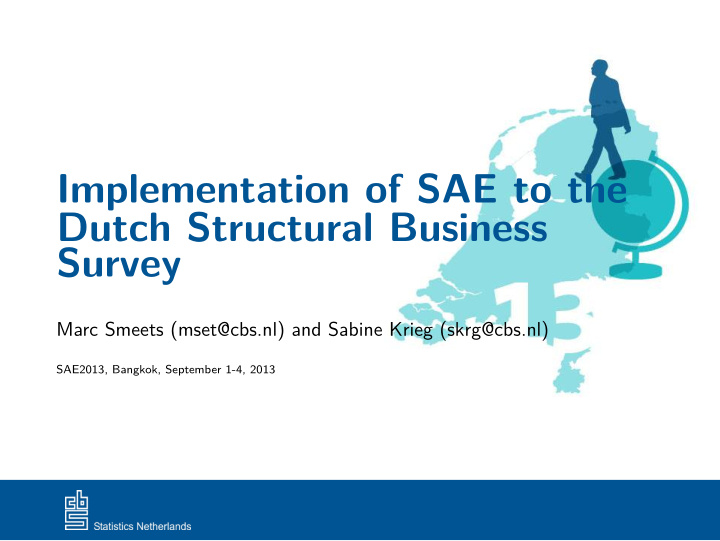



Implementation of SAE to the Dutch Structural Business Survey Marc Smeets (mset@cbs.nl) and Sabine Krieg (skrg@cbs.nl) SAE2013, Bangkok, September 1-4, 2013
Introduction Research into application of small area estimation (SAE) to business surveys. Target variables: continuous and skewly distributed, large differences between enterprises and existence of outliers, variables with many zeroes. Model specification: random slope models, transformation of variables, unequal variance structure. In collaboration with University of Southampton (Nikos Tzavidis, Hukum Chandra): M-Quantile estimation, ... 2
Aims of current research Consideration of Dutch Structural Business Survey (SBS). Measurement of annual total production and cost-benefit structure of enterprises in the Netherlands. Focus on one sector: the retail trade. Getting reliable and consistent estimates for a selection of 9 (related) structural variables, at different publication levels, satisfying preconditions imposed by production process. Investigating possibilities and (eventually) implementation of SAE. 3
Structural target variables Variables and relations returns − costs = results = turnover + other returns returns = costs of goods sold + personnel costs costs + depreciation + other costs Abbreviation of variable names = T − C R T = T 1 + T 2 = C 1 + C 2 + C 3 + C 4 C 4
Publication levels Based on Standard Industrial Classification (SIC): classification of enterprises according to economic activity, represented by 5 digit SIC-code. Given by 5digit cells, industries, sectors and whole population formed by combinations of SIC-codes, publication levels are nested, totals should add up to totals at higher level. Sampling design SBS stratified at the level of industries sample sizes industries are fixed, sample sizes 5digit cells are random and can be 0. Retail trade: 71 5digit cells and 27 industries. 5
Earlier results Considered situations turnover per industry, results , returns and costs per 5digit cell. Considered estimators EBLUP (J.N.K. Rao, 2003), SAEtrans (C. Chandra and R. Chambers, 2011) M-Quantile estimator (R. Chambers and N. Tzavidis, 2006) GREG, Survey Regression (C. Särndal et al, 1992) Results SAE more accurate than GREG and Survey Regression, for industries M-Quantile most accurate, for 5digit cells EBLUP, SAEtrans most accurate if no strong covariate available ( tax turnover ). 6
Preconditions production process Totals of industries must be estimated by linear weighting based on the generalized regression estimator (GREG, Särndal et al, 1992). turnover is replaced by tax turnover totals of turnover equated with totals of tax turnover , totals of other variables estimated with turnover as covariate and totals of tax turnover as population totals. 7
Considered estimator EBLUP based on following model (J.N.K. Rao, 2003): x t ij β + z t = ij ϑ j + e ij , where y ij ∼ N ( 0 , Θ ) , ϑ j N ( 0 , k 2 ij σ 2 ∼ e ) , for 5digit cell j and enterprise i . e ij Specification of k ij analysis of heteroscedasticity and skewness residuals e ij , stratum standard deviations residuals of estimated regression model. Specification of x ij and z ij analysis of AIC, point estimates, significance estimates of β , tax turnover and size of enterprise used as covariates, random slopes for T 2 , C 2 , C 3 and C 4 , otherwise z ij = 1. 8
Consistency Consistency by Lagrange multiplier with absolute values of point estimates used as weights. Three versions of consistent EBLUPs EBLUPc1: consistent within the 5digit cells, between all 1 variables, EBLUPc2: consistent between variables and publication levels, 2 EBLUPc3: consistent between variables, publication levels and 3 equated totals of turnover and tax turnover . Simulation based on response data 2006-2010, N = 47127, n = 3036, m = 71, 10000 runs. Means sample sizes 5digit cells vary from 0 . 1 to 436. 9
Effects of benchmarking 10
EBLUP vs Survey regr. (not consistent) 11
EBLUPc3 vs Survey regr. (consistent) 12
Conclusions SBS estimates 5digit cells can be improved by SAE for most variables, for other variables results are comparable. Equating turnover with tax turnover gives good results for turnover , returns , costs , but has not much effect for other variables. Benchmarking with direct estimates at industry level leads to instable estimates at level of 5digit cells for variable results . Estimates for variables with many zeroes ( results , other returns , other costs ) could possibly be further improved. 13
Recommend
More recommend